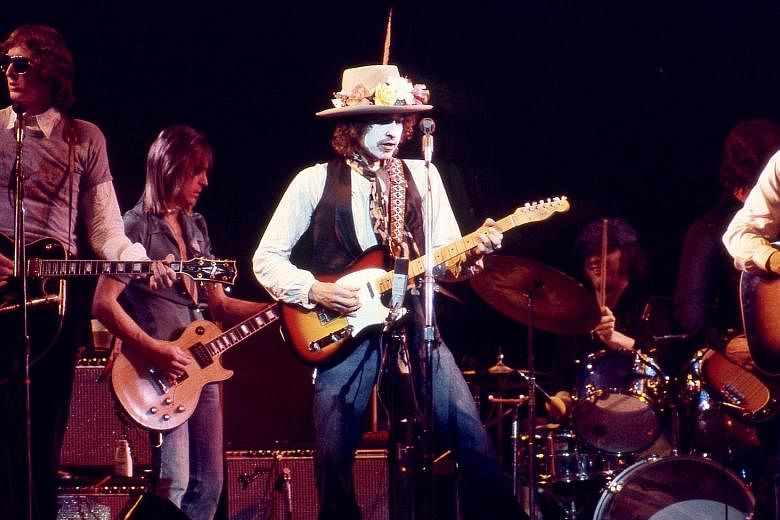LOS ANGELES • The clues that there is something wonky about director Martin Scorsese's new Bob Dylan documentary come quickly but subtly.
In fact, it starts with the pre-title sequence - a turn-of-the-century, black-and-white vignette of a magician throwing a blanket over a woman and making her disappear, the cuts clearly visible where the film was edited.
The title, Rolling Thunder Revue: A Bob Dylan Story By Martin Scorsese, which omits the word "documentary", raises an eyebrow.
But the biggest clue arrives via current-day Dylan himself, when Scorsese asks him about the 1975 tour at the heart of the new Netflix film.
"I wouldn't say it was a traditional revue, but it was in the traditional form of a revue," the 78-year-old singer-songwriter says.
He continues: "I'm trying to get to the core of what this Rolling Thunder thing is all about and I don't have a clue. Because it's about nothing. It's just something that happened 40 years ago."
In 1966, Dylan had become the "voice of a generation", to borrow a phrase he hated.
The megastar's disinterest in fame, coupled with a motorcycle accident in upstate New York, led him to stop touring for several years. Then, in 1974, a stadium tour with The Band left him bored and exhausted.
So, the next year, he gathered a group of artists, including Joan Baez (a former girlfriend), Patti Smith, Joni Mitchell, poet Allen Ginsburg, playwright Sam Shepard and more to play at tiny venues, mostly around New England.
A travelling circus of sorts. As you might imagine, it was the sort of tour that launched rock 'n' roll myth upon rock 'n' roll myth - especially so with a troubadour like Dylan, who donned a beflowered bowler hat and white face paint through his performances, singing with a punk rocker's anger and insistence.
Scorsese's documentary plays into this very mythos by presenting a whole lot of fiction as fact.
It is probably unlike any music documentary viewers have seen because a good bit of it is completely fabricated nonsense.
It is an interesting way to explore Dylan, a man who would often obscure details of his life - pretending to be from New Mexico, for example, instead of his native Minnesota.
"Life isn't about finding yourself or finding anything," he tells Scorsese in the film. "Life is about creating yourself and creating things."
Here are the three biggest stories they created.
FILM-MAKER STEFAN VAN DORP
The "documentary" includes a great deal of behind-the-scenes tour footage supposedly shot by European film-maker Stefan van Dorp.
Van Dorp is not a real person. Martin von Haselberg, a performance artist and singer Bette Midler's husband, portrayed him in the film - and the footage comes from Renaldo And Clara, a four-hour movie by Dylan and Shepard that mixed concert footage with vignettes they co-wrote.
Many of the fictional bits featuring Dylan and Baez come from the 1978 flop.
SHARON STONE AND DYLAN'S AFFAIR
In the documentary's most compelling and surprising sequence, Sharon Stone tells a story about going to see the concert, at 19, with her mother, both of them as Dylan's personal guests.
As the actress tells it, she was wearing a Kiss shirt, which prompted a conversation about kabuki. Stone says she later joined Dylan on the tour and the two hint that they had a love affair.
Sure, this one is technically impossible to disprove, but it can be pretty much assured to be false.
First, the tour did not stop in Stone's home town in Pennsylvania. Second, she would have been 17, not 19.
Third, there has literally never been a mention of the two until this documentary. Fourth, she and Scorsese have a history of working together, notably in the 1995 movie, Casino.
CONCERT PROMOTER JIM GIANOPULOS
A great deal of the film is based on interviews with Jim Gianopulos, presented as the concert promoter who helped conceive of and book the tour, all the while wishing Dylan would still play stadiums.
There is a good chance his name sounded slightly familiar, though most viewers probably just assume he was someone who often comes up in rock documentaries.
He is not. Mr Gianopulos is the chief executive officer of Paramount Pictures.
Before that, he was the chairman of Fox Filmed Entertainment. He had nothing to do with the tour.
WASHINGTON POST

